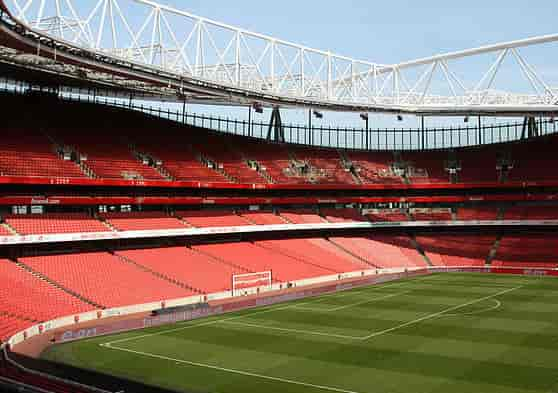Table of Contents
ToggleThe Premier League Arsenal Stadium, Emirates Stadium
Name: Emirates Stadium
Location: Highbury House, London, England
Owner: Kroenke Sports & Entertainment
Capacity: 60,704
Record attendance: 60,383 (Arsenal vs Wolverhampton Wanderers, 2 November 2019)
Opened: 22 July 2006
Construction cost: £390 million (2004)
The Emirates Stadium, also known as Arsenal Stadium for UEFA competitions, is the Premier League Arsenal’s stadium. Located in Holloway, London, this iconic venue has been the cherished home of Arsenal since its grand unveiling in 2006.
With a seating capacity of 60,704, the stadium ranks as the fifth-largest football stadium in England by capacity. This article delves into the captivating history of this stadium, from its inception to its significance today.
History
In 1997, Arsenal decided to create a new stadium after facing planning restrictions on expanding their beloved Highbury stadium. Several possibilities were explored, including the purchase of Wembley Stadium.
However, the club ultimately decided to acquire a land estate in Ashburton Grove in 2000. This marked a pivotal moment in Arsenal’s history, setting the stage for a transformative relocation project.
Overcoming Obstacles
The path to the Emirates Stadium was not without challenges. Early plans to rebuild Highbury faced opposition from local residents, while the East Stand was designated as a Grade II listed building.
Despite these obstacles, Arsenal pressed on, examining the feasibility of Ashburton Grove. The battle for approval from local residents, support from key figures like Ken Livingstone, and multiple legal challenges ultimately paved the way for construction.
New Stadium Creation Financing
Securing funding for this ambitious project proved daunting, as one of the most popular Premier League football clubs, Arsenal received no public subsidies. The club needed to find innovative ways to generate income.
Measures such as player trading, sponsorship deals with Granada Media Group, and a groundbreaking bond scheme were implemented. In 2004, Emirates acquired naming rights for the stadium, marking a significant financial milestone.
Emirates Construction and Opening
The actual construction of the Emirates Stadium began once funding was secured. Sir Robert McAlpine was appointed for the building work, with Populous serving as the architect. The stadium featured state-of-the-art facilities, including HDTV streaming.
It was ceremonially opened on October 26, 2006, by Prince Philip, Duke of Edinburgh, after Queen Elizabeth II suffered an injury. This marked a historic moment, echoing the royal presence at Highbury in 1932.
The Emirates Stadium underwent a transformation starting in 2009, known as “Arsenalisation.” Feedback from supporters played a crucial role in this initiative. Changes included white seats in the pattern of the club’s cannon logo, the creation of “The Spirit of Highbury” shrine, and exterior murals celebrating Arsenal legends and moments. This project aimed to make the stadium a visible stronghold of Arsenal’s heritage.
Emirates Structure and Facilities
Described as “beautiful” and “intimidating,” the Emirates Stadium boasts an innovative design by Populous. It features a translucent polycarbonate roof, allowing ample sunlight and airflow to the pitch.
The stadium’s premium seating areas, known as the “Club Level,” offer an exceptional matchday experience. Furthermore, the stadium offers facilities for fans with disabilities, including sensory rooms.
Emirates Stadium Future
The Emirates Stadium continues to evolve. In 2022, one of the most popular football clubs in the world, Arsenal announced renovation plans aimed at improving the stadium’s amenities, including new video boards and enhanced mobile connectivity. With a season ticket waiting list of 40,000, the stadium’s allure remains as strong as ever.
Conclusion
The Emirates Stadium stands tall as a symbol of Arsenal FC’s unwavering commitment to excellence and progress. From its beginnings to its current iconic status, this stadium is more than just a football ground; it’s a testament to the club’s rich history and bright future. As it continues to evolve and adapt, the Emirates Stadium remains at the heart of Arsenal and a cherished landmark in the world of sports.


